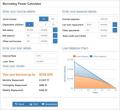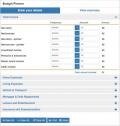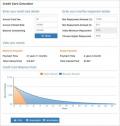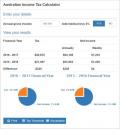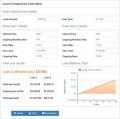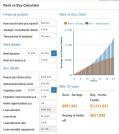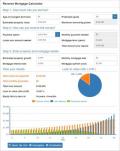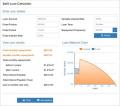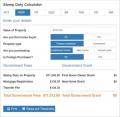You can calculate how much you can afford to borrow, taking into account your income, current loans and expenses.
This is a comprehensive, yet easy to use, budget planner. You can input your income and expenses including rates, phone, insurance, super, loans and leisure, on a weekly, fortnightly, monthly or annual basis. You get provided with a summary report.
This calculator enables you to calculate the comparison rate. It takes into account the introductory interest rate, a reverting interest rate and any fees over your selected term.
This calculator allows you to see how long it will take to pay off your credit card by paying the minimum repayment versus making higher repayments.
This quick and easy calculator does provide you with an estimate of your age pension entitlement. Warning, this calculator does have limitations and is just for simple illustrations only.
This calculator shows the time and interest saved when payments are increased on a long term loan.
This calculator demonstrates the interest saved and the time saved in paying off your mortgage by having a home loan offset account.
This calculator provides the honeymoon repayment amount and reverting repayment amount of a Honeymoon Loan. It also provides a comparison of the interest paid on the Honeymoon rate versus if there was no Honeymoon rate.
This calculator shows the time it will take to repay a loan and the interest paid after you input the loan amount, interest rate and your repayment amount.
The Association of Superannuation Funds of Australia (ASFA) regularly survey their members to determine what a comfortable or modest retirement income means. This calculator provides you detail as to what a typical retirement income means for a single or a couple in Australia.
Brighter Super has produced this calculator that enables you to have a general picture of what will be your likely superannuation account at retirement. It also enables you to calculate what difference it would make to your retirement balance if you made certain changes now; for instance, putting more money into your super account.
This calculator allows you to estimate your gross pay based on your net pay for a given period as well as helps you to understand the amount of tax payable and your tax to gross income ratio (which differs to your marginal tax rate).
The Income Tax Calculator calculates the net income using the tax rate tables obtained from the Australian Tax Office website. You can calculate what income tax you would pay on different gross income levels. Calculations do not include Medicare Levy or HECS payments.
This leasing calculator calculates the monthly payment required, the total payments over the life of the lease and the total interest payable. You can input the purchase price, the residual, the interest rate and the term.
This calculator enables you to compare two loans with different variables. You can input the loan amount, loan term, fees, any introductory interest rate and the reverting interest rate.
This calculator provides a schedule of your monthly repayments, and shows you what portion goes towards interest and what portion goes toward paying off the principal amount borrowed. You can calculate the changes to your monthly repayments for different loan amounts, interest rates and payment terms.
This calculator shows the time saved to pay off a loan and the amount of interest saved, if a single additional lump sum repayment is made.
This calculator helps you understand whether you may save money by making a switch from your existing mortgage to another as well as the benefit of making higher repayments instead of minimum repayments.
This calculator enables you to calculate the costs associated with buying a property. The costs can include government charges such as stamp duty, lenders fees such as loan application fees and other costs such as pest inspections or insurance. You are provided with a summary page.
This calculator enables you to calculate the costs associated with selling a property. The costs can include agent fees such as commission, lenders fees such as exit costs and other costs such as removalist costs. You are provided with a summary page.
This calculator provides you an estimate of your long term financial position when comparing the decision to either rent (and save) or purchase a main residence (and grow home equity).
This calculator will help you to get an idea of how long your portfolio will last after you retire.
The reverse mortgage calculator assists when you are looking at using the equity in your home to help fund your retirement. It reviews how much you can borrow and how you receive the money. You can input the interest rate and the fees and determine at what time the equity in your home becomes zero.
This calculator calculates the total accumulation in a savings or investment account. You can choose the regular deposit frequency, the initial amount, the regular deposit amount, the term and earning rate.
This calculator looks at how long it will take to reach your savings goal by considering three main variables that will impact on the time-frame required to meet your targeted savings goal: your current savings balance, investment earnings, and planned regular contributions.
This calculator considers the amount you will need to contribute to your savings, depending on your deposit frequency, to reach your savings goal by considering three main variables that will impact on the contribution amount required to meet your targeted savings goal: your current savings balance, investment earnings, and planned time-frame.
This calculator shows the total interest amount under a variable interest rate for the full loan term compared to the same loan having a fixed rate component. You can enter the fixed rate and the term.
This calculates transfer duty, mortgage duty, mortgage registration and transfer fees for various types of properties.
This calculator shows the total accumulated balance and interest paid in a term deposit account. You can input the initial deposit amount, the interest rate and investment term.











